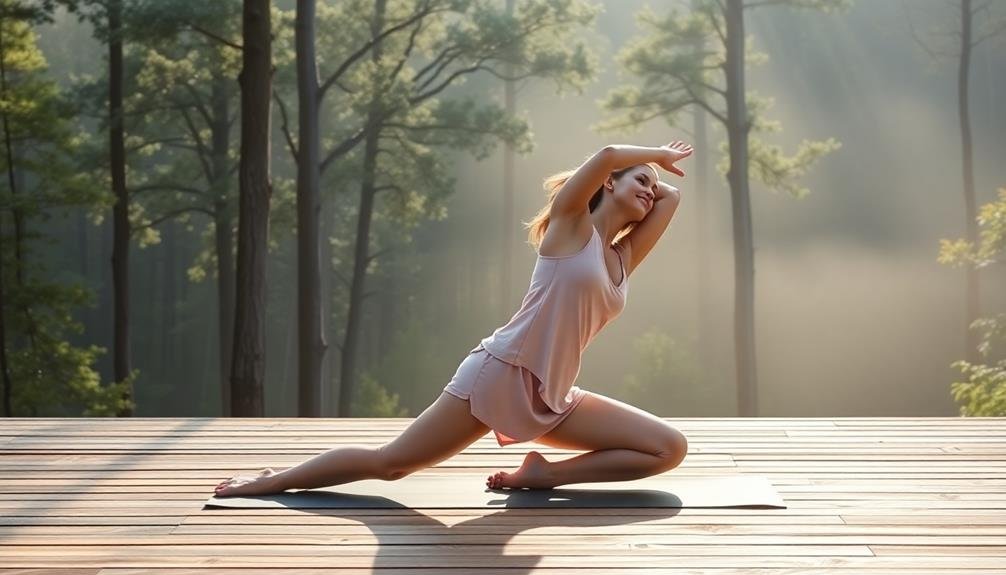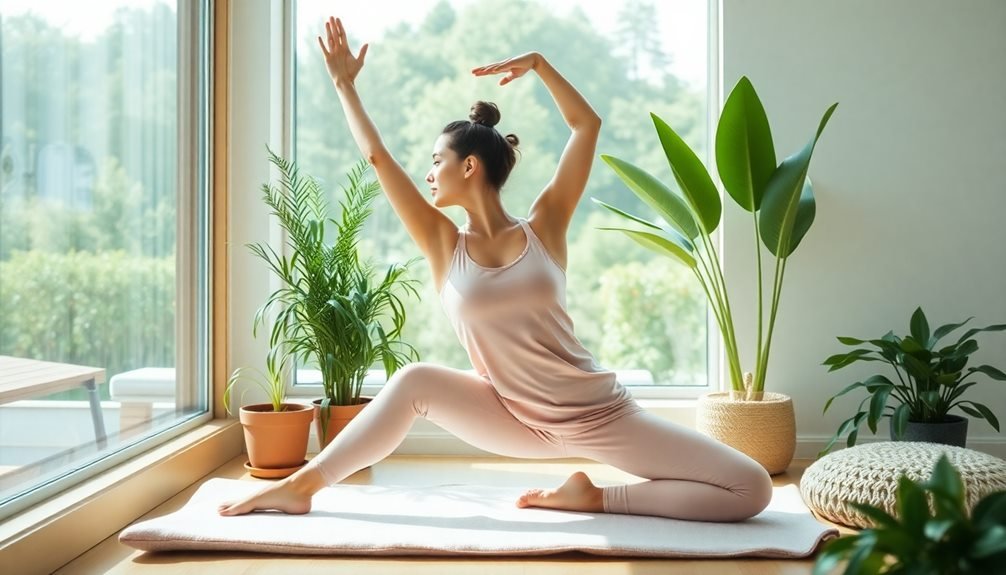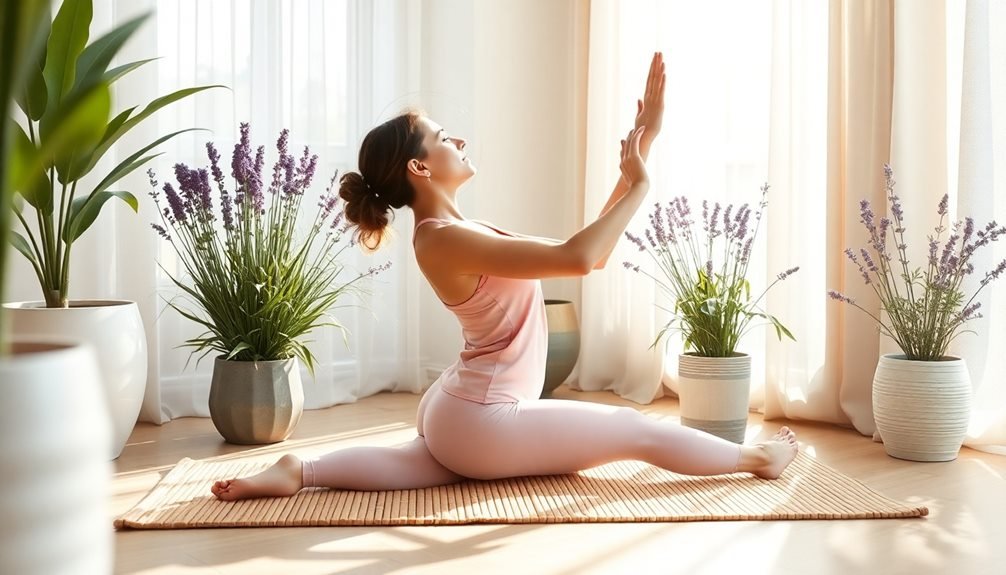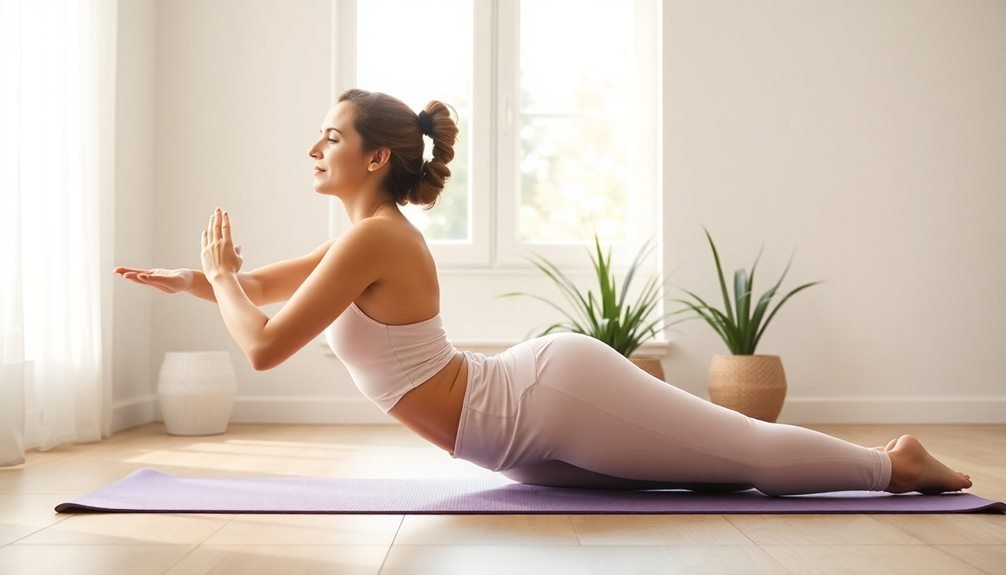Gentle yoga offers a natural path to ease depression and anxiety. You'll focus on slow, mindful movements and deep breathing, promoting relaxation and stress reduction. This practice can help reduce negative thought patterns, increase self-awareness, and enhance emotional regulation. To start, you'll need minimal equipment and a quiet space. Begin with beginner-friendly poses like Child's Pose and Cat-Cow Stretch, gradually building a daily routine. Consistency is key to experiencing mental health benefits. By incorporating breathwork, simple poses, and mindfulness techniques, you'll create a powerful tool for managing your symptoms. Discover how gentle yoga can transform your approach to mental wellness.
Key Takeaways
- Gentle yoga emphasizes slow movements and breathwork, promoting relaxation and reducing stress for those with depression or anxiety.
- Regular practice of gentle yoga can reduce negative thought patterns and increase self-awareness and emotional regulation.
- Beginner-friendly poses like Child's Pose and Cat-Cow Stretch are accessible and beneficial for mental health.
- Incorporating mindfulness techniques during yoga practice enhances its effectiveness in managing depression and anxiety symptoms.
- Combining gentle yoga with traditional therapies creates a holistic approach to treating depression and anxiety naturally.
Understanding Gentle Yoga

Serenity lies at the heart of gentle yoga, a practice that emphasizes slow, mindful movements and breathwork. Unlike more vigorous forms of yoga, gentle yoga focuses on relaxation, flexibility, and stress reduction.
You'll find that this approach is particularly beneficial if you're dealing with depression or anxiety, as it encourages a calm state of mind and body awareness.
In gentle yoga, you'll typically engage in simple poses that are easy to modify and hold for longer periods. These may include seated forward bends, gentle twists, and supported reclined positions.
The practice often incorporates props like blankets, blocks, and bolsters to guarantee comfort and proper alignment.
Breathwork, or pranayama, plays an essential role in gentle yoga. You'll learn to use your breath as a tool for managing stress and promoting relaxation.
This aspect of the practice can be especially helpful in calming anxious thoughts and lifting your mood.
Gentle yoga also emphasizes mindfulness, encouraging you to stay present in the moment and observe your thoughts without judgment.
This mindful approach can help break negative thought patterns associated with depression and anxiety.
Benefits for Mental Health

Gentle yoga offers numerous benefits for your mental health, particularly when dealing with depression and anxiety. It's a powerful tool that can help you manage stress, improve mood, and enhance overall well-being.
By practicing gentle yoga regularly, you'll notice a positive shift in your mental state and emotional balance. The slow, mindful movements and focused breathing in gentle yoga activate your body's relaxation response. This helps reduce cortisol levels, the stress hormone that can exacerbate symptoms of depression and anxiety.
You'll also find that gentle yoga improves your sleep quality, which is essential for maintaining good mental health.
Here are five key mental health benefits of gentle yoga:
- Reduces rumination and negative thought patterns
- Increases self-awareness and emotional regulation
- Promotes mindfulness and present-moment focus
- Enhances feelings of calm and inner peace
- Boosts self-esteem and body image
As you continue your gentle yoga practice, you'll develop a greater sense of control over your thoughts and emotions.
This newfound mental clarity and emotional stability can greatly improve your ability to cope with depression and anxiety symptoms, leading to a more balanced and fulfilling life.
Getting Started With Gentle Yoga

To begin your gentle yoga practice for depression and anxiety, you'll need minimal equipment and a quiet space.
Start with beginner-friendly poses like child's pose, cat-cow stretch, and seated forward bend.
Establish a routine by setting aside 10-15 minutes daily, gradually increasing the duration as you become more comfortable with the practice.
Essential Equipment and Space
When starting on your gentle yoga journey, you'll need surprisingly little equipment and space to get started. A yoga mat is your primary essential, providing a non-slip surface and cushioning for your practice. If you don't have a mat, a carpeted area or even a towel can suffice initially.
Comfortable, stretchy clothing that allows for easy movement is vital. You'll want to create a quiet, calm space where you can focus without distractions.
For props, consider having a couple of sturdy pillows or yoga blocks to support your body in certain poses. A yoga strap or a long belt can help with stretches and maintaining proper alignment. Remember, you don't need a large area – a space about the size of your mat plus some room to extend your arms is usually enough.
Here's a quick checklist of essentials:
- Yoga mat or non-slip surface
- Comfortable, flexible clothing
- Quiet, distraction-free space
- Pillows or yoga blocks for support
- Yoga strap or long belt for stretching
With these basics in place, you're well-equipped to begin your gentle yoga practice for managing depression and anxiety.
Beginner-Friendly Poses
Starting your gentle yoga practice with beginner-friendly poses can help you ease into the routine while reaping the benefits for depression and anxiety.
Begin with Child's Pose, a calming position that stretches your back and hips. Kneel on the floor, sit back on your heels, and extend your arms forward.
Next, try Cat-Cow Pose to gently warm up your spine. On your hands and knees, alternate between arching and rounding your back.
Practice Mountain Pose to improve posture and balance. Stand tall with your feet hip-width apart, engage your core, and relax your shoulders.
Shift to Tree Pose to enhance focus and stability. Shift your weight to one foot and place the other foot on your inner thigh or calf.
For a gentle backbend, try Bridge Pose. Lie on your back, bend your knees, and lift your hips.
Finally, end with Corpse Pose for deep relaxation. Lie flat on your back, close your eyes, and focus on your breath.
Hold each pose for 5-10 breaths, listening to your body and modifying as needed. Remember, consistency is key in experiencing the mental health benefits of gentle yoga.
Creating a Routine
Now that you're familiar with some beginner-friendly poses, it's time to establish a consistent gentle yoga routine. Start by setting aside 15-20 minutes daily, preferably at the same time each day. Choose a quiet, comfortable space where you won't be disturbed.
Begin with a few minutes of deep breathing to center yourself, then move through a sequence of 5-7 poses, holding each for 3-5 breaths. As you progress, gradually increase the duration and complexity of your routine. Listen to your body and adjust as needed.
Remember, consistency is key in reaping the mental health benefits of gentle yoga. To create a well-rounded practice, incorporate:
- Breathing exercises (pranayama)
- Gentle stretches
- Balance poses
- Seated or reclined postures
- A brief meditation or relaxation at the end
Don't worry about perfecting each pose; focus on the mind-body connection and how you feel. If you're struggling to maintain motivation, consider joining a class or finding an online community for support.
With regular practice, you'll likely notice improvements in your mood, stress levels, and overall well-being.
Simple Poses for Anxiety Relief

When you're feeling anxious, focusing on your breath through simple yoga poses can help calm your mind.
You'll find relief in gentle, breath-centered postures that allow you to connect with your body and slow racing thoughts.
Try incorporating grounding floor sequences into your practice to feel more stable and centered during moments of anxiety.
Calming Breath-Focused Poses
Tranquility awaits in the domain of breath-focused yoga poses. These gentle movements, synchronized with your breath, can help calm your mind and soothe anxiety. As you practice, focus on deep, steady inhalations and exhalations, allowing each breath to guide your body's movement.
Start with a simple seated pose, like Easy Pose (Sukhasana). Close your eyes and breathe deeply, feeling your chest and belly expand with each inhale. Move on to Cat-Cow Pose, flowing between arching and rounding your spine with each breath.
Try Child's Pose, allowing your forehead to rest on the mat as you breathe slowly and deliberately. For a standing practice, try Mountain Pose (Tadasana) with raised arms. As you inhale, lift your arms overhead; as you exhale, bring them back to your sides.
Finally, practice Standing Forward Bend (Uttanasana), focusing on the sensation of your breath as it moves through your body.
- Breath connects mind and body
- Each inhale brings new energy
- Each exhale releases tension
- Mindful breathing reduces stress
- Regular practice builds resilience
Grounding Floor Sequences
Grounded in the earth's stability, floor sequences offer a powerful antidote to anxiety. These poses help you connect with the supportive surface beneath you, calming your nervous system and promoting a sense of security.
Start by sitting cross-legged in Easy Pose, focusing on the connection between your sit bones and the floor. Close your eyes and take a few deep breaths, allowing tension to melt away.
Move into Child's Pose, stretching your arms forward while your forehead rests on the mat. This gentle inversion can soothe an overactive mind and release shoulder tension.
From here, shift to Cat-Cow, synchronizing your breath with the movement to create a meditative flow.
Next, try Seated Forward Bend, reaching for your toes while keeping your spine long. This pose can help quiet racing thoughts and relieve stress.
Breathing Techniques for Calmness

Breath serves as a powerful tool for managing depression and anxiety symptoms. By focusing on your breathing, you can calm your mind and body, reducing stress and promoting relaxation.
One effective technique is diaphragmatic breathing, where you breathe deeply into your belly rather than shallowly into your chest. This activates your body's relaxation response, lowering heart rate and blood pressure.
Another helpful method is the 4-7-8 breath. Inhale for 4 counts, hold for 7, and exhale for 8. This pattern helps regulate your nervous system and can be particularly useful during moments of intense anxiety.
Box breathing, where you inhale, hold, exhale, and hold again for equal counts, is another calming technique you can practice anywhere.
Here are five key benefits of incorporating breathing techniques into your yoga practice:
- Reduces stress and anxiety levels
- Improves focus and concentration
- Enhances emotional regulation
- Boosts overall mood and well-being
- Promotes better sleep quality
Mindfulness in Gentle Yoga Practice

Mindfulness forms the foundation of a gentle yoga practice for managing depression and anxiety. It's the act of being fully present in the moment, observing your thoughts and sensations without judgment.
As you move through gentle poses, focus on your breath and bodily sensations. Notice the feeling of your feet on the mat, the stretch in your muscles, and the rhythm of your breathing.
When your mind wanders, as it inevitably will, gently guide your attention back to your body and breath. This practice helps you develop a non-reactive awareness of your thoughts and emotions, reducing their power over you.
You'll learn to observe negative thoughts without getting caught up in them.
Incorporate mindfulness into your gentle yoga routine by pausing between poses to check in with yourself. How do you feel physically and emotionally? What thoughts are arising?
Practice accepting whatever you're experiencing without trying to change it. This acceptance can be a powerful tool in managing depression and anxiety, allowing you to respond to challenges with greater calm and clarity.
Creating a Relaxing Yoga Environment

Transform your space into a soothing sanctuary for your gentle yoga practice. Choose a quiet area in your home where you won't be disturbed. Clear clutter and create an open, inviting space that allows for free movement.
Soft, warm lighting can help set a calming mood – consider using dimmer switches or candles. Incorporate natural elements like plants or a small indoor fountain to bring a sense of tranquility.
Select comfortable, supportive props like yoga mats, blankets, and bolsters to enhance your practice. Use soothing colors in your decor, favoring cool blues, gentle greens, or warm earth tones. Temperature is essential; make sure the room is comfortably warm to relax your muscles.
To deepen your relaxation and focus, consider:
- Playing soft, ambient music or nature sounds
- Using essential oils or incense for calming aromatherapy
- Hanging inspiring artwork or affirmations on the walls
- Keeping a journal nearby for post-practice reflection
- Incorporating a small altar with meaningful objects
Incorporating Yoga Into Daily Routine

Once you've created your ideal yoga space, it's time to weave gentle yoga into your daily life. Start small by dedicating just 10-15 minutes each morning to a simple yoga routine. This consistency will help build a lasting habit and provide a positive start to your day.
Choose a few basic poses that resonate with you, such as Child's Pose, Cat-Cow, or Gentle Twists. As you become more comfortable, gradually increase the duration and complexity of your practice.
Don't forget to incorporate breathwork and meditation into your routine, as these elements are essential for managing depression and anxiety.
Consider setting reminders on your phone or placing yoga props in visible areas to prompt your practice. You can also integrate mini yoga sessions throughout your day, like doing desk stretches during work breaks or practicing a calming pose before bed.
Combining Yoga With Other Therapies

Yoga's gentle approach to healing can be even more powerful when combined with other therapeutic modalities. By integrating yoga with traditional treatments, you'll create a holistic approach to managing depression and anxiety.
Consider incorporating yoga into your existing therapy regimen, whether it's cognitive-behavioral therapy, medication, or counseling. This combination can enhance your overall well-being and provide a more thorough treatment plan.
When combining yoga with other therapies, you'll experience a synergistic effect that addresses both mind and body. You'll learn to apply mindfulness techniques from yoga to your daily life, reinforcing the coping strategies you've developed in therapy.
Additionally, the physical benefits of yoga can complement the emotional work you're doing, helping to reduce stress and improve your overall mood.
Here are five ways yoga can enhance other therapies:
- Reinforces mindfulness skills learned in therapy
- Provides a physical outlet for emotional stress
- Improves body awareness and self-acceptance
- Enhances relaxation techniques taught in counseling
- Supports medication effects by promoting overall well-being
Remember to communicate with your healthcare providers about incorporating yoga into your treatment plan. They can help you find the right balance and guarantee that all aspects of your therapy work together effectively.
Frequently Asked Questions
Can Gentle Yoga Be Practiced During Pregnancy?
Yes, you can practice gentle yoga during pregnancy. It's a safe and beneficial way to stay active, reduce stress, and prepare for childbirth. However, you'll need to modify certain poses and consult your healthcare provider before starting.
How Long Does It Take to See Results From Gentle Yoga?
You'll likely notice some benefits from gentle yoga within a few weeks. However, results vary depending on your consistency, goals, and individual circumstances. You may experience improved flexibility, reduced stress, and better sleep relatively quickly.
Are There Any Age Restrictions for Practicing Gentle Yoga?
You'll find that gentle yoga doesn't have age restrictions. It's suitable for all ages, from kids to seniors. You can start at any time in your life. Just listen to your body and modify poses as needed.
Can Gentle Yoga Help With Chronic Pain Conditions?
Yes, gentle yoga can help with chronic pain conditions. You'll find it can improve flexibility, strengthen muscles, and reduce stress. It's a low-impact exercise that you can adapt to your needs, potentially easing various types of chronic pain.
Is It Necessary to Have Special Equipment for Gentle Yoga Practice?
You don't need special equipment for gentle yoga. A yoga mat is helpful but not essential. You can use a towel or practice on carpet. Comfortable clothing and a water bottle are all you'll really need to start.
In Summary
You've discovered a powerful tool for managing depression and anxiety naturally. By incorporating gentle yoga into your daily routine, you're taking an active role in your mental health. Remember, consistency is key. Start small, be patient with yourself, and gradually build your practice. As you continue, you'll likely notice improvements in your mood, stress levels, and overall well-being. Don't hesitate to combine yoga with other therapies for a holistic approach to mental wellness.





Leave a Reply